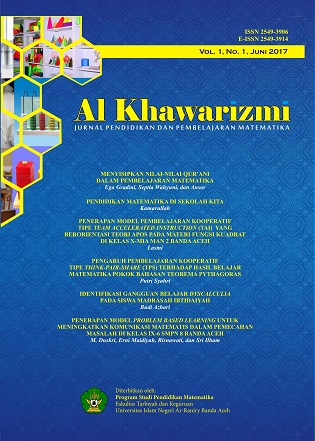IDENTIFIKASI GANGGUAN BELAJAR DYSCALCULIA PADA SISWA MADRASAH IBTIDAIYAH
DOI:
https://doi.org/10.22373/jppm.v1i1.1732Keywords:
identification, learning problems, dyscalculiaAbstract
Dyscalculia is a kind of problems facing by many pupils beside of low-level reading skills. In fact, reading and basic arithmetic operation skills are very important in learning other subjects. The purpose of this study was to examine learning problems of dyscalculia students. The subjects of this study were five Madrasah Ibtidaiyah (MI) in Kabupaten Aceh Tamiang. The results showed that dyscalculia students face some difficulties in understanding the concepts or the process of calculation since they find some difficulties in visual processing. Moreover, dyscalculia students also face some difficulties in counting the numbers according to their sequences, memorizing and applying mathematical operations. As the consequence, dyscalculia students face some difficulties in solving even a simple mathematical problem.References
Abdurrahman, M. (2012). Anak Berkesulitan Belajar Teori, Diagnosis dan Remidiasinya. Jakarta: Rineka Cipta.
Ayuningtyas, D. M. dan Suwarno (2016). Diskalkulia pada Kelas V SDN Kebonromo 3 Kecamatan Ngrampal Kabupaten Sragen Tahun Pelajaran 2015/2016. Surakarta: Universitas Muhammadiyah Surakarta.
Bryant, D. P. (2005). Social Integration of Students with Autism in Inclusive Settings. Division on Developmental Disabilities, Council for Exceptional Children.
Bynner, J. and Parsons, S. (1997). Does Numeracy Matter? London: The Basic Skills Agency. Institute of Education: London.
Cohen K. R., J. Lammertyn, and V. Izard (2008). Are numbers special? An overview ofchronometric, neuroimaging, developmental and comparative studies of magnitude representation. Progress in Neurobiology. US
Geary, D. C. (2004). Mathematics and LearningDisabilities.Journal of Learning Disabilities, Volume 37, Number 1, January/February 2004.
Miles, M. B. & Huberman, A. M. (1992). Analisis Data Kualitatif. Terjemahan oleh Tjetjep R. Rohidi.Jakarta: Universitas Indonesia (UI-Press).
Moleong (2001). Metodologi Penelitian Kualitatif. Bandung: RemajaRosdakarya.
Mussolin, C., A. De Volder, C. Grandin, X. Schlogel, M. C. Nassogne, and M. P. Noel (2010). Neural Correlates of Symbolic Number Comparison in DevelopmentalDdyscalculia. Journal of Cognitive Neuroscience. 22 (5): 860-874. http://dx.doi.org/10.1162/jocn.2009.21237
Price, G. R. and Ansari, D. (2013). Dyscalculia: Characteristics, Causes, and Treatments. Western University: Scholar Commons.
Purohit, Seema dan Sampada Margaj (2012). “Analysis and Detection of Dyscalculia at Early Age Using Computer Assisted Friendly Tests (CrAFT)â€. International Journal of Emerging Technology and Advanced Engineering Mumbai India (2) 12. ISSN 2250-2459. Diakses pada 21 Desember 2015 dari http://www.ijetae.com/ files/Volume2Issue12/IJETAE_1212_53.pdf.
Rosselli, M. (2006). Memory Abilities in Children With Subtypes of Dyscalculia. Developmental Neuropsychology, Vol 30 (3). Lawrence Erlbaum Associates, Inc.

